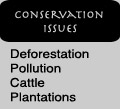


Desert habitats
In this episode we'll learn:
- What defines a desert?
- Where are deserts found?
- What causes a desert?
- Rainshadow effect.
- Adaptations to life.
Desert Communities
What defines a desert?
A desert is defined simply by the amount of rainfall that falls in an area in conjunction with the amount of evaporation. In essence, its any area that receives on average less than 10 inches of rainfall per year, and where the yearly evaporation is more than 10 inches of rain a year.
Where are deserts found?

Deserts are found around the globe, generally around a belt of 30 degrees north and south latitude where global wind patterns carry down dry air from the upper atmosphere.
What causes a desert?
Deserts can be caused by any factor that limits rainfall. I've come up with three such reasons here:
Rain shadow effect: These deserts are formed on the leeward side of large mountain ranges. Think of the desert of Nevada caused by the Sierra Nevadas. As the moisture in the air goes up and over these ranges, it cools, depositing its moisture load on the range. By the time the air comes down, it has very little moisture left ... thus causing a desert. Another good example of this can be found on island ecosystems where there is a predominant wind direction. Hawaii is a great example. Waikiki and Diamond Head receive only about 13 inches of rain a year ... nearly a desert!
Cold Ocean/Warm Land: Around the tropic of cancer and Capricorn, is an area of world that tends to have dry air coming down from the upper atmosphere, causing high pressure systems and dry air. Combine this with the fact that the ocean currents tend to move cold ocean water down certain sides of the continents (The western sides in the north and the eastern sides in the south). Whenever you combine a cold ocean with a warm land, you're not going to have much rainfall. Cold oceans simply provide very little moisture content, while the warm land, evaporates heavily. More simply, think about the mirror in the bathroom when you shower. The reason water condenses on the mirror is because its much cooler than the rest of the air. Warm land won't allow that condensing effect.
Interior Basins: The final type of desert can form when a piece of land is simply too far from a source of moisture. Take the Sahara or Gobi deserts as examples.
Adaptations to life in a desert
To survive in the desert you need to optimize your water use. Many plants have come up with a unique type of photosynthesis that allows them to only open their pores at night (C4 plants). Animals must also be able to conserve water. Reptiles produce a type of concentrated urate instead of our normal liquid waste to excrete ammonia.
Find out more:
 |
 |
||
 |
 |
||
 |
 |

